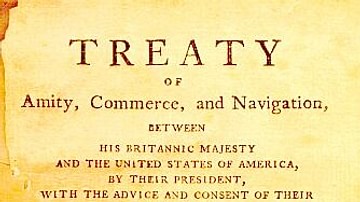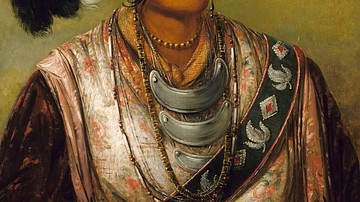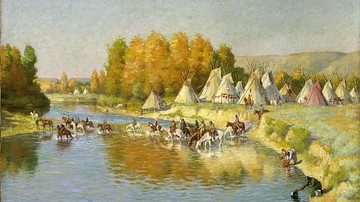The Chinook people (Chinookan peoples) are a Native American nation of the US Pacific Northwest who inhabited the region of modern-day southwest Washington state and northern Oregon; many Chinookans still live there. Among their most famous stories are the Chinook Creation Tale and the Blue Jay tales, the latter featuring Blue Jay, the Chinookan trickster figure.

Like the Saynday tales of the Kiowa, Wihio tales of the Cheyenne, and Iktomi tales of the Sioux, the Blue Jay tales of the Chinookan peoples always feature the trickster figure Blue Jay and, often, his long-suffering older sister Ioi, who must endure his constant lies (though he famously always claims it is she who is telling untruths) and often outrageous behavior.
In the two Blue Jay tales given below, Blue Jay takes a wife from the Land of the Dead and then abandons her once her people ask him for proper tribute (Blue Jay Finds a Wife) and, in How the Sun Was Stolen, inadvertently helps a man disguised as a slave steal the sun from the daughter of the Sun Keeper by lying to the people (and his brother Robin) about his relationship with the "slave" in order to enhance his status.
The Chinook Creation Tale is an account of how the Chinook came to be but also serves as an origin tale on the proper way to prepare salmon, a staple of the Chinook diet, and the origin of the Thunderbird, a popular supernatural entity, sometimes deity, featured in the myths and legends of many of the Native peoples of North America. Together, these three tales offer a glimpse into the culture of the Chinook people.
Chinookan Peoples & Culture
The Chinook are best known in Euro-American history from their 1805 interaction with the Lewis and Clark Expedition (1804-1806) when they aided the party, but the Chinookan peoples had lived for centuries before that time along the waterway now known as the Columbia River. According to some scholars, Chinook may mean "fish eaters", owing to their reliance on fish as a staple in their meals (though this claim has been challenged). They were originally a hunter-gatherer people before establishing permanent communities distinguished by their longhouses (plankhouses, approximately 150 ft/45 m long by 60 ft/18 m wide), which were homes to extended families of sometimes up to 40 or 50 people.
Men hunted (primarily elk), fished (usually spearfishing for salmon), defended the village, made war, and brought home captives, who were then either ransomed or used as slaves. Women built the homes, gathered herbs, edible plants, nuts, and roots, made clothing and footwear, raised the children, and prepared the meals. Both girls and boys could participate in the vision quest when they reached adolescence, and women and men could both serve as shamans ("medicine men" and "medicine women") in the community.
The Chinook believed (and still believe) in a single Great Spirit Creator God (Neahkanie) who made and maintains the world with the assistance of other supernatural entities such as elemental spirits of the earth, water, air, and fire. Nature spirits are understood as a simple reality of life for the Chinook as are guardian spirits who assist and guide one through life. As with most, if not all, Native American peoples, the Chinook believe in an afterlife similar to their experiences on earth but without sickness, sorrow, disappointment, deprivation, or, of course, death.
Chinookan society was stratified, and the upper class of some bands practiced head binding (flattening the forehead and skull of children from infancy to around their first birthday) to distinguish them from the "round heads" of the lower classes. It is for this reason that the Chinookan peoples were often referred to as the "Flathead Indians" by the early European explorers who encountered them. Some bands also practiced slavery, but no flat-headed individuals of the upper class could be enslaved, only the "round heads" of the lower classes or those of other nations who had been taken captive in warfare.
Chinookan Legends & Language
The Chinookan practice of slavery is reflected in How the Sun Was Stolen when Kali-qoo disguises himself as a slave, so no one will pay any attention to him, once he reaches the country of the Sun Keepers. Blue Jay almost ruins his plans by claiming, falsely, that Kali-qoo was once a slave of his family. Blue Jay does this to enhance his standing as a member of an upper-class slave-holding family. The bureaucracy instituted by the upper class is clearly referenced in Blue Jay Finds a Wife when each village Blue Jay comes to in the Land of the Dead passes him on to the next because they are only allowed to deal with those who have been dead for a certain amount of time.
The Blue Jay tales, overall, are an interesting introduction to Chinookan culture as the central character frequently mocks the rules and regulations of the upper class either by appearing as one of them, pretending to be one of them, or behaving in ways they would disapprove of. At the same time, like all trickster figures, Blue Jay offers an audience the opportunity to learn from his mistakes or the errors of others he points out and so change their own errant behavior. Any trickster tale revolves around the concept of transformation, and those of the Chinook are no exception. An original audience for a recitation of Blue Jay Finds a Wife would have found the story quite amusing as the hope of resurrecting the dead wife is consistently crushed by the bureaucracy and established rules of each village.

Even so, this is not to say that the Chinookan peoples had no respect for authority or sought to undermine their leaders. Religious rituals and festivals (such as the First Salmon Rite) and ceremonies (such as the potlatch, during which participants shared what they had with others in gratitude for what they had been given) followed the same tradition for centuries, and the sexes maintained their traditional roles until contact with Europeans and Euro-Americans.
Although the Chinook had lived on the land for centuries before the arrival of the Europeans, and have a legitimate claim to their ancestral lands, they have been denied federal recognition (an injustice suffered by many Native American nations) by the US government, which means they are denied resources that same government promised them in the 19th century. They were recognized as a "legitimate nation" in 2001, but this status was later rescinded. The Chinook have been fighting for federal recognition from a government that stole their lands since 1851. Their struggle continues in the present day.
The Chinook languages were diluted by so-called "Chinook Jargon" – a mix of Chinook, English, and French – which came to be used in trade with non-Natives. Traditional tales were recited in the original language, but as the population declined through the introduction of European diseases and conflict with Euro-Americans and other Native nations, the language has been nearly lost. Efforts by anthropologists, including Franz Boas (l. 1858-1942), preserved the stories in English, and the Chinookan peoples today are trying to revive their traditional language; one aspect of that initiative is the telling of the old tales in the original tongue.
Text
The following tales are taken from Indian Legends of the Pacific Northwest (2003) by Ella Clark (the Chinook Creation Tale), the website Native Languages of the Americas (native-languages.org), and Myths of the North American Indians (2018) by Lewis Spence (the Blue Jay tales).
Chinook Creation Tale
Long, long ago, when Old Man South Wind was traveling north, he met an old woman who was a giant.
"Will you give me some food?" asked South Wind. "I am very hungry."
"I have no food," answered the giantess, "but here is a net. You can catch some fish for yourself if you wish."
So Old Man South Wind dragged the net down to the ocean and with it caught a little whale. Taking out his knife, he was about to cut the whale and take out the blubber.
But the old giantess cried out, "Do not cut it with a knife, and do not cut it crossways. Take a sharp shell and split it down the back."
But South Wind did not take to heart what the old woman was saying. He cut the fish crossways with his knife and began to take off some blubber. He was startled to see the fish change into a huge bird. It was so big that when it flew into the air, it hid the sun, and the noise of its wings shook the earth. It was Thunderbird.
Thunderbird flew to the north and lit on the top of Saddle Mountain, near the mouth of the Columbia River. There it laid a nest full of eggs. The old giantess followed the bird until she found its nest. She broke one egg, but it was not good. So she threw it down the mountainside. Before the egg reached the valley, it became an Indian.
The old giantess broke some other eggs and then threw them down the mountainside. They too became Indians. Each of Thunderbird's eggs became an Indian.
When Thunderbird came back and found its eggs gone, it went to South Wind. Together they tried to find the old giantess, to get revenge on her. But they never found her, although they traveled north together every year.
That is how the Chinook were created. And that is why Indians never cut the first salmon across the back. They know that if they should cut the fish the wrong way, the salmon would cease to run. Always, even to this day, they slit the first salmon down the back, lengthwise.
Blue Jay Finds a Wife
Blue Jay was a trickster who enjoyed playing clever tricks on everyone, especially his sister Ioi. As she was the eldest sister, Blue Jay was supposed to obey her. But he deliberately misinterpreted what she said, excusing himself by saying, "Ioi always tells lies."
Ioi decided that it was high time for Blue Jay to quit his playful life of trickery and settle down with a wife. She told him that he must select a wife from the people of the land of the dead, who were called the "Supernatural People." Ioi recommended that Blue Jay choose an old woman for a wife and suggested the recently deceased wife of a chief. But Blue Jay balked; he wanted a young and attractive woman. He found the corpse of a beautiful young girl and took it to Ioi, who advised him to take the body to the land of the dead to be revived.
Blue Jay set out on this journey and arrived at the first village of the Supernatural People. They asked him, "How long has she been dead?" "Only a day," he answered. The Supernatural People of the first village then informed him that there was nothing they could do to help him; he must go on to the village where people who were dead for exactly one day were revived.
Blue Jay arrived at the second village the next day and asked the people to revive his wife. The people here too asked him how long she had been dead. "Two days now," he replied. "There is nothing we can do; we only revive those who were dead exactly one day." So Blue Jay went on.
He reached the third village on the day after that and asked the people to revive this wife. "How long has she been dead?" they asked. "Exactly three days now." "Most unfortunate," they replied. "We can only revive those who have been dead exactly two days." And so it went on from village to village until Blue Jay finally came to the fifth village, where the people could at last help him. The people of the fifth village liked Blue Jay and made him a chief. But the trickster tired of the Underworld and wanted to take his newly revived wife back to the land of the living.
When Blue Jay arrived at home with his wife, her brother saw she was alive once more and ran to tell their father, an old chief, who demanded that Blue Jay cut off all of his hair as a gift to his new in-laws. When there was no response from Blue Jay, the chief became angry and led a party of male relatives to find him. Just as they nearly caught him, Blue Jay assumed the form of a bird and flew off again to the land of the dead.
At this, his wife's body fell to the ground, lifeless. She went to meet her husband in the land where he was now an exile.
How the Sun Was Stolen
Once upon a time, there lived a chief who kept the sun in a box. When his daughter went to gather berries, she carried the box along and opened it a little so that she was able to see. When she had filled her basket, she carried the box home to her father.
The people in other countries were very poor. They held a council in which they deliberated how they might obtain the sun. Finally, they decided to send Kali-qoo to the chief to steal the sun.
When he reached the country, he assumed the shape of an old slave. The people found him and took him home to their chief. Blue Jay lived in the house of the latter. He said "Oh, that used to be my father's slave. He lost him one day. His grandfather had been my father's slave." The people believed him and gave him to Blue Jay.
When the chief's daughter went picking berries; they took him along to paddle the canoe. He was a very good oarsman, and Blue Jay said, "That is Tsi sti saatq, he was a very good oarsman." And they believed him. When they were traveling along, the slave began to say "Tses, tses, tses." The Blue Jay said to his brother Robin, "He always spoke so when he carried me about when I was a little boy." But the Robin did not remember. And Blue Jay said, "Oh, you are good for nothing,. You are older than I am, and you do not remember him."
Finally they arrived at the berry patch and the girl opened the box a little. As soon as the sun appeared, the slave jumped up, seized the box and opened it. And it became daylight. He ran away and they were unable to catch him. The people almost killed Blue Jay because his lies had been the cause of their losing the sun.
Kali-qoo took the sun home to his chief, who gave it to the people saying, "Henceforth, we will all enjoy the sun and not one man alone shall have it."






